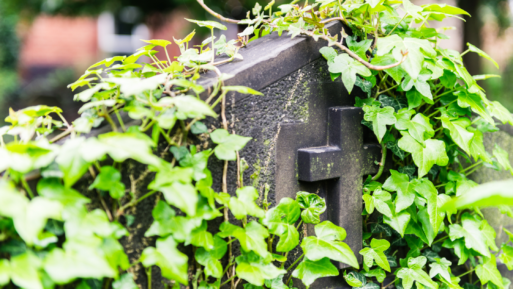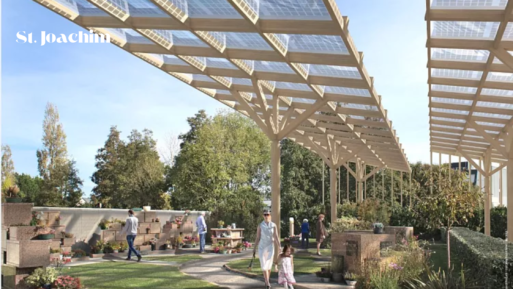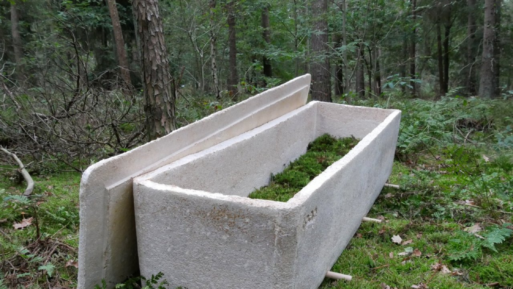
In case you haven’t noticed: it’s hot outside. According to the National Oceanic and Atmospheric Administration, 2023 was the warmest year since global records began in 1850. In fact, the 10 warmest years in our 174 years of recording global temperatures have all occurred during the last decade (2014-2023). It’s getting harder to ignore the effects of climate change all around us, and people are finally paying attention. As a result, innovators across the globe have been looking for ways to decrease our carbon footprint, and some interesting ideas have come to light, particularly in the death care industry.
The Environmental Costs of Traditional Death Care Practices
Each year in the U.S. alone, burials are estimated to use 4.3 million gallons of embalming fluid, 64.5 thousand tons of steel, 1.6 million tons of reinforced concrete and 20 million board feet of hardwood. The chemicals and materials used when burying a human body cause soil pollution as they break down, and graveyards occupy valuable tracts of land at an unsustainable rate.

Many cemeteries use”vaults” to maintain level, even ground, and occupy valuable tracts of land.
Cremation has often been considered a more environmentally friendly funeral option, but unfortunately, that’s not really the case. While cremation consumes less land resources, the process utilizes fossil fuels and emits substantial amounts of greenhouse gasses. Cremating a single corpse takes up to three hours of burning and releases almost 600 pounds of carbon dioxide into the atmosphere. According to National Geographic, experts estimate that cremation is responsible for millions of metric tons of carbon dioxide emissions around the globe.
Interesting Innovations
These staggering numbers, coupled with increasing concerns about climate change, have fueled a burgeoning movement to create and find alternative, “greener” death care options. Some of these options involve taking an innovative approach to handling our bodies after death, and others are looking at utilizing traditional burial grounds in more sustainable ways.
French Town Makes Local Cemetery a Source of Solar Energy
As a solution to a convoluted water problem, the town of Saint-Joachim has proposed a unique method of honoring their dead while providing electricity to the living.

Solar panels over the cemetery will provide valuable resources to St. Joachim
Source: St. Joachim township
A small town north of the Loire estuary, Saint-Joachim is one of several “islands” that are scattered among the vast peat bogs that make up the Brière marsh. Because their cemetery is right at sea level, it floods in winter, making it difficult to navigate and unpleasant to visit. As a proposed solution, the mayor suggested installing covers over the area to protect the site from filling up with rainwater and using the collected precipitation to water adjacent areas that suffer from drought in the dry summer months. Making the “cover” of the cemetery into solar panels was just their “pièce de résistance.”
According to Éric Broquaire, a local resident and president of the Brier’energie association, the collected solar power is projected to cover around 20% of the town’s power usage. A prototype of the solar covers they plan to use was installed over a small portion of the cemetery in March, and the newly-solar cemetery is hoping to provide a cheap, clean flow of electricity to the town starting summer of 2025.
A Different Use for Solar Power in India
The National Thermal Power Company based in New Delhi is planning to set up a crematorium that will use solar thermal energy to reduce their use of natural gas and resources. The Indian power conglomerate said that as of right now, between 500-600 kilograms of wood are used to cremate a dead body, taking a heavy toll on local forests. The new solar-powered crematoriums would use mainly solar power, with gas or other resources only used as a reserve fuel. They also said that they would install systems for conditioning the gasses released by the system, to ensure a safe dispersal into the environment.

The proposals are still in the developmental stages, but hopefully the industry will take notice of their efforts and follow suit.
Netherlands-Based Startup Hopes People Will Opt for “Living Coffin”
Traditional death care practices typically involve embalming a body before it is placed inside a wood and metal casket, often lined with synthetic fabric. The casket is then lowered into a grave in which a vault – essentially a rectangular container constructed of plastic, metal, concrete, or some combination of these materials – has been placed. The vault serves to prevent the grave from collapsing when the coffin (and the body inside of it) eventually decompose.
All of these burial materials come at a steep environmental cost to produce and utilize. As an alternative, a startup comprised of researchers at the Technical University of Delft in the Netherlands – Loop – has developed a “living coffin” out of mycelium – the root structure of mushrooms – and up-cycled hemp fibers.

Loop’s “Living Cocoon”
Source: Loop Biotech
Mycelium is nature’s industrious recycler, transforming dead organic matter and pollutants into key nutrients for new seedlings. (Picture the mushrooms you might find on a fallen log in the woods; those are the visible signs of mycelium breaking the dead tree down into soil.)
Loop’s Living Cocoon takes several weeks to form, as the mycelium mat is grown in the shape of a coffin and then allowed to dry naturally. Before burial, a soft bed of moss is laid inside, which will help the decomposition process. As soon the mycelium is exposed to damp soil again, it will come back to life and begin assisting the decomposition process.
Loop claims that their coffin will not only hasten the decomposition process – reducing the typical time frame of over a decade to as little as three years – but also contribute valuable compost and nutrients back into the soil. Their mission is to change the death care industry from one that pollutes the environment with dead materials, to one that enriches it. The first funeral to be held using one of Loop’s cocoons was conducted in the Netherlands in March of 2020.

 The Death Care Industry is Going “Greener”
The Death Care Industry is Going “Greener”




 Composting Bodies Is Now Legal in a Dozen States
Composting Bodies Is Now Legal in a Dozen States














